Q&A Report: In Vivo Modeling of Immune-mediated Optic Neuropathies

The answers to these questions have been provided by:
Oliver W. Gramlich, PhD
Research Assistant Professor
Ophthalmology and Visual Sciences
The University of Iowa
Why are the impairments in optic nerve conduction speed so small?
We think this is because of the timing when we recorded the VEP, which was 21 days after injection of the disease-specific antibodies. We probably would see a more pronounced delay in latency after a longer time.
How much damage is caused just by the injection into the optic nerve itself and how can you be sure that the degeneration is specific to the NMO and MOGAD antibodies? How variable are the phenotypes?
We used a nonspecific antibody, 2B4, as a comparator and found a certain degree of visual impairment 4 days after injection. However, recovery was much faster with a higher magnitude when compared to injection of disease-specific antibodies. More recent OCT data show significant thinning in animals having received disease specific antibody injections when compared to 2B4.
Did you test whether human derived MOG-ABs are binding to rat tissue? Did you test this with 8-18-C5 as well?
We did not test 8-18-C5. Some preliminary tissue array experiments show binding of the human MOG serum derived antibodies to rodent tissue. However, confirmatory experiments are still pending.
Why did you use Long Evans rats in the NMO model?
Long Evans rats are complement-competent animals of which changes in visual function and structure (visual acuity, OCT, and electrophysiology) can be measured. In addition, the animal’s size is ideal for performing surgeries to access the optic nerve.
How did you identify gentisic acid as a potential modulator of the cholesterol transporter 1 expression?
We used Advaita’s iPathwayGuide software for our RNA-seq analysis to identify potentially targetable pathways which includes literature database searches. One hit as a potential modulator of ABCA1 was gentisic acid.
What was the dose of the gentisic acid in vivo?
50mg/kg once per week.
How to determine the dose of GA?
The optimal dosage of gentisic acid was determined based on preliminary in vitro and in vivo experiments and based on literature research.
What other effects other than increasing Abca1 expression does Gentisic acid have?
Gentisic acid treatment has potentially pleiotropic effects that affect cholesterol synthesis in the retina and cause increased myelin debris clearance after demyelinating events. Furthermore, it has been reported that Gentisic acid directly interferes with inflammatory pathways and most likely acts as a Cyclooxygenase inhibitor.
What is the bioavailability of gentisic acid? Does it reach the eye and retina?
We did not conduct a pharmacokinetic profiling; however, the literature indicates that gentisic acid is able to pass the Blood-Brain/Retina barrier.
Are variations in OMR and pattern ERG/VEP good enough for preclinical in vivo drug testing? Since these drug related improvements might just be like 10%~20%?
In terms of drug testing related to vision, Yes! OCT, VEP and visual acuity readouts have been used as secondary readouts in clinical studies for testing of new MS drugs. Implementation of these visual systems biomarkers in preclinical settings significantly increases the scientific rigor due to their highly translational value. However, other confirmatory outcome measurements should also be considered.
In the brain organoids, any other evidence that GA is enhancing myelination and not just OPC proliferation?
Our RT-PCR results indicate that PLP and MYRF expression is significantly increased in gentisic acid-treated brain organoids. Thus, it is conceivable that we have enhanced myelination.
Latency is changed only by flash VEP. What is the difference between flash VEP and other VEP measurement?
Generally speaking, the flash VEP signal highly depends on the retinal input, whereas the pattern VEP signal recapitulates the electrical activity of the visual pathway, driven by foveal vision. The reason why changes in the pattern VEP in our experiments are so small may be because rodents don’t have a fovea and significant changes in latency may only be evident after massive demyelinating events.
What is the stain used for staining the optic nerve?
Luxol Fast Blue combined with standard H&E.
Is there indications if persons with high cholesterol levels have an altered visual acuity? Or the other way around: is high cholesterol a risk factor for optic nerve atrophy?
There is some evidence in the current literature that high cholesterol levels in combination with hypertension may increase the risk for optic neuropathies.
